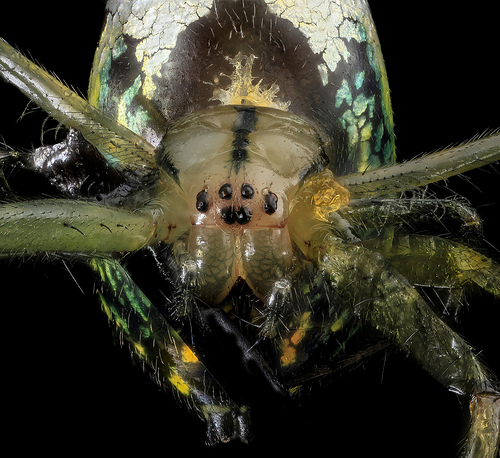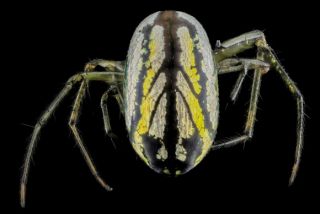Venusta Orchard Spider

Taxonomy:
Chelicerates (Chelicerata) » Arachnids (Arachnida) » Spiders (Araneae) » True Spiders (Araneomorphae) » Entelegynes » Long-jawed Orb Weavers (Tetragnathidae) » Leucauge »Credit: Slpaok Perez
Physical Description
The Venusta Orchard spider is an orb-weaver with a slightly different web look and physical appearance themselves than other orb-weavers. Its legs are very thin with a bulbous abdomen [source]. Their colors range from a combination of orange or yellow with green or blue. These are normally the colors on the underside of their abdomen (the side most people see) while their thin legs can be a dark green or even black. Many people are fascinated with this spider because it’s colors are so bright and showy.Size & Location
These spiders are fairly small considering they normally will not get any larger than an inch wide. The males are typically half the size of the females. Though these spider aren’t popular for their size, nonetheless, they are very popular in their common appearance throughout several large areas. They range from southern Canada all the way to Central America. They prefer moist woodland areas and have a tendency to build their webs close to the ground using bushes and small trees as classic posts for their orb webs.The Venusta Orchard Spider
Who is the Venusta Orchard Spider related to?
These arachnids were originally grouped into the famous family Araneidae (Orb-Weavers), but they have recently been separated into the family Tetragnathidae (Long-Jawed Orb-Weavers) because of their long fangs. Even so, they still have much in common with the Araneidae family besides the slight difference in the webs mentioned below and of course the fangs. Their is no doubt that the Long-Jawed orb-weaver family has a very new and interesting look to them aside from the orchard spider that is by far more eye-catching, but is still fairly ordinarily shaped. Some of the others in this family are anything but ordinarily shaped. Though we don’t have much information about it yet, the Tetragnatha straminea is a very unique looking spider with an abnormally long abdomen which shares the same family as the orchard spider.Prey & Predators
This spider preys on anything that can get caught in its strategically placed web such as flies, small moths, leaf insects, and generally speaking any ground hopping or flying insects as big or smaller than the spider. Its predators range from larger spiders, larger flying insects (such as some wasps), birds, and small animals.Harmful to Humans?
Though these orchard spiders are different from the original orb-weaving family, it’s temperament is still alike. They are mild-tempered and not harmful to humans. Though, that only applies to the species we have documented so far. If anything, they are helpful to human in their instinctive ability to catch our pests.Type Of Web
These spiders build orb webs, but not just your common orb web. The Venusta Orchard Spider withholds some slightly different craftsmanship. The most visible difference between this spider’s web and other orb-weavers is that the orchard spider has an open center while other common orb-weavers normally make their web centers very thick. The web is also normally horizontal which demonstrates the preference of this spider to, in most all cases, hang upside-down while waiting on its prey [source].Other Names
Strategus AloeusExtra Information
Unlike many other species to whom the males are eaten by the female after mating, these particular spiders use their fangs to their advantage. While mating the male has already locked his fangs into the female to ensure she will not take his life. Therefore, the males have longer life spans than other typical male spiders in other families.External links:
http://www.cirrusimage.com/spider_Venusta_Orchard.htm
http://www.naturelssi.com/?p=1704
http://bugguide.net/node/view/1958


